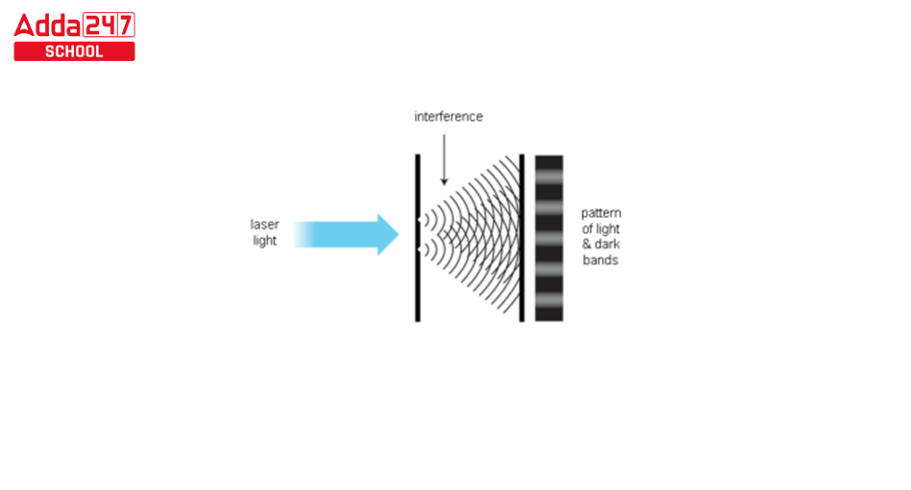Interference of Light
Interference of light is a phenomenon that occurs when two or more waves of light come together. In such a situation, these waves get combined. When these waves meet each other, these waves can strengthen each other as well as destroy each other. Under this whole process, bright or dark-colored bands are formed which are known as Interference fringes.
Interference of light Meaning
Interference of light is a phenomenon in which two or more light waves interact with each other as they superpose or overlap. When these waves meet, their amplitudes add or subtract, leading to constructive or destructive interference, respectively. The result is the modification of the overall intensity or brightness of light at specific points in space where the waves overlap
What is Interference of Light
Interference of light is a phenomenon that occurs when two or more light waves superpose or overlap with each other. When light waves meet, they combine, and their amplitudes add together at various points. Depending on whether the waves are in phase (constructive interference) or out of phase (destructive interference), different effects are observed.
- Constructive Interference: Constructive interference occurs when two or more light waves meet in such a way that their crests (peaks) align with each other, and their troughs (valleys) also align. As a result, the amplitudes of the waves add up, leading to a more intense and brighter light at the point of superposition. This can produce regions of increased brightness, known as interference maxima.
- Destructive Interference: Destructive interference occurs when two or more light waves meet in such a way that their crests align with the troughs of the other waves. In this case, the amplitudes cancel each other out, resulting in reduced or even complete darkness at the point of superposition. This creates regions of decreased brightness, known as interference minima.
Interference of light is a fundamental concept in the field of optics and plays a crucial role in various phenomena, such as the formation of interference patterns in Young’s double-slit experiment, thin-film interference (as seen in soap bubbles or oil slicks), and in optical devices like interferometers used for precise measurements in research and industry. It is a phenomenon that has helped scientists understand the wave nature of light and contributed to numerous advancements in physics and engineering.
Example of Interference of Light
Real-life examples of interference of light are phenomena such as the color patterns commonly seen in soap bubbles, rings around street lights at night, or the shimmering colors seen in oil droplets on water.
In simple words, if it is written in a short form, then when the waves of light do this process with each other, it is called Interference of Light. Under this process, light waves can create constructive or destructive patterns.
Kinematics Equations and It’s Derivation, Variables,Dynamic Equation
Interference of Light Examples in Daily Life
Some of the 5 real-life examples of Interference of Light are as follows-
- Soap bubbles: The iridescence seen on soap bubbles is due to the interference of rays of light reflected from the surface of the film.
- Thin Film Interference: When light waves pass through or are reflected from a thin film such as on water, oil, or a layer of glass they can interfere with each other and create colored patterns.
- Diffraction Grating: Under Diffraction Grating, when rays of light pass through a series of equally spaced parallel lines in a CD-DVD, they can interfere with each other and form a rainbow-like pattern of colors.
- Young’s Double Slit Experiment: In this experiment, light is passed through two narrow slits, and interference returns to a screen behind them, which displays the wave-like nature of light.
- Newton Ring Experiment: When a convex lens is placed over a flat glass surface under the Newton Ring Experiment, a pattern of concentric rings of bright and dark fringes can be seen due to the interference of reflected light waves between the two surfaces.
What is a Cyclone? Know All about the Cyclone Disaster
Interference of light Reasons
Below we have given you some main reasons for the Interference of Light-
- When two or more tricolors of light meet, then these waves can strengthen each other and can also harm each other.
- Interference arises due to the wave nature of light.
- The coherence of light sources plays an important role in interference.
- The distance between the sources and the observer affects the observed interference pattern.
- Any interference of incident and reflection can cause.
- Refraction of light at the boundaries of objects can cause interference.
- The polarization of light can cause interference.
- Interference of light can arise due to the Diffraction of light over the obstacles of light.
Carbonic Acid Formula, Structure, Strength, Preparation
Types of Interference of Light
The interference of light is divided into two parts, which are divided based on their nature and the result of construction-
- Constructive Interference
- Destructive Interference
Constructive Interference of Light
Constructive interference of light is observed when two light waves with the same frequency and phase interfere, and combine to produce a wave with a larger amplitude.
In other words, the crests of the light waves and their troughs become a line due to which a bright spot can be seen in the interference pattern.
Young’s double-slit experiment is generally considered the best example of constructive interference of light.
Read: Ammonia Formula, Structure, Symbol
Destructive Interference of Light
Destructive interference of light is observed when two or more waves of light meet and tend to cancel each other. As a result of which the amplitude of light decreases.
For example, noise-canceling headphones are the best example of destructive interference to cancel background noise. Also, the thin film coating on the glasses uses harmful interference to reduce glare and increase visibility.
These are all real-life examples of Destructive Interference.
Difference between interference and Diffraction of light
If we talk about Interference and Diffraction, then both these incidents happen in such a situation when the wave of light interacts with each other or with the obstacles. Interference occurs when two or more waves of the light mix, and either strengthen or destroy each other. On the other hand, Diffraction occurs when the wave of light bends around an obstacle or hole and bends and spreads in all directions.
The following differences can be seen in Diffraction and Interference of light
| Interference | Diffraction |
| Interference occurs when waves meet. | Diffraction occurs when the wave bends around an obstacle. |
| Interference can be either constructive or destructive. | Diffraction always causes the spreading of a ray of light. |
| Bright and dark interference fringes can be seen in the interference pattern. | The diffraction pattern consists of a central bright spot surrounded by rings of diminishing intensity. |
| The interference of light is more noticeable when the waves have the same frequency and the phase difference is also the same. | Diffraction is more noticeable when the obstacle is of the same size as the wavelength of the wave. |
| At least 2 waves of light are required for the interference of light. | For the Diffraction of light, only one wave of light is sufficient. |
| Controlling interference patterns can be used in applications such as interferometry. | Diffraction patterns are used to determine the size of small particles or to study crystal structures. |
Principle of superposition
Principle of superposition [in the context of interference of light]
The principle of superposition states that when two or more waves of light collide, the total displacement at any given point is the sum of the individual displacements of each wave.
In the context of interference of light, this principle explains how interference patterns can be formed when two coherent light waves interfere constructively or destructively.
Difference between Coherent and Incoherent sources of light
Coherent and incoherent sources as sources of light is a term used to describe the phase relationship between the waves emitted by a light source, and the difference between coherent and incoherent sources of light is as follows-
| Coherent sources of light | Incoherent sources of light |
| Coherent sources of light emit waves with a constant phase relationship. | An incoherent source of light emits waves with a random phase relationship. |
| The interference pattern is produced when two or more rays of light from coherent light sources meet each other. | This does not happen with Incoherent sources of light. |
| Coherent sources of light have a well-defined frequency. | Incoherent of light does not have a well-defined frequency. Their frequency range is very large. |
| Coherent sources of light can usually be seen with lasers or special lamps. | Incoherent sources of light can be any type of light source. |
| Coherent sources of light produce a narrow beam of light. | Incoherent sources of light produce a wide beam of light. |
| Coherent sources produce monochromatic light. | Incoherent sources produce polychromatic light. |
| Coherent sources of light emit waves that are in phase. | Incoherent sources of light emit rays that are out of phase. |
| Coherent sources of light produce a single mode of oscillation. | Incoherent sources of light produce several modes of oscillation. |
| Coherent sources of light emit more directional light. | Incoherent sources of light emit light in all directions. |
| Coherent sources of light produce a high degree of spatial coherence. | Incoherent sources of light produce little or no spatial coherence. |
| Coherent sources emit light with a constant phase relationship over long distances. | Incoherent sources emit light with a random phase relationship over short distances. |
| The light of a coherent source is of narrow bandwidth. | Incoherent sources produce light of a wide bandwidth. |
| Coherent sources produce excessive collateral radiation. | Incoherent sources produce diverging rays. |
| Interference fringes produced by a coherent source are more pronounced, sharper, and defined. | Incoherent sources produce fuzzy poorly defined interference fringes. |
| Coherent sources are used for holography and other applications that require precise control of the phase of light. | Incoherent sources of light are used in illumination and imaging applications. |
| Coherent sources of light are more expensive and complex. | Incoherent sources of light do not have to be expensive and complicated. |
| Coherent sources can be used for interferometry. | Incoherent sources of light cannot do this. |









 BTEUP Result 2025 Out at bteup.ac.in, Do...
BTEUP Result 2025 Out at bteup.ac.in, Do...
 SGBAU Result 2025 Out, Check Summer Seme...
SGBAU Result 2025 Out, Check Summer Seme...
 How To Prepare for CUET Accountancy Exam...
How To Prepare for CUET Accountancy Exam...









